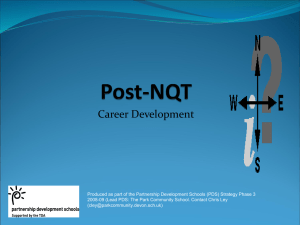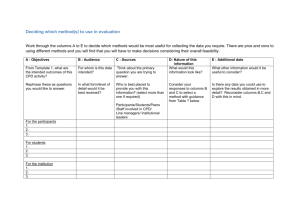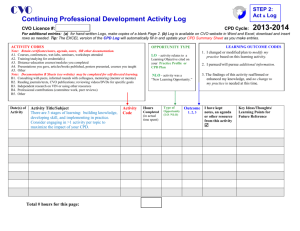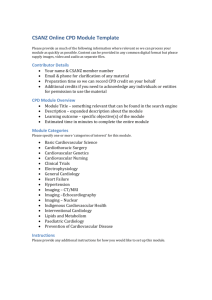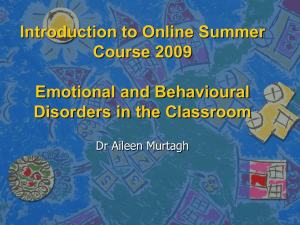Continuing Professional Development – resource guide 2015
advertisement
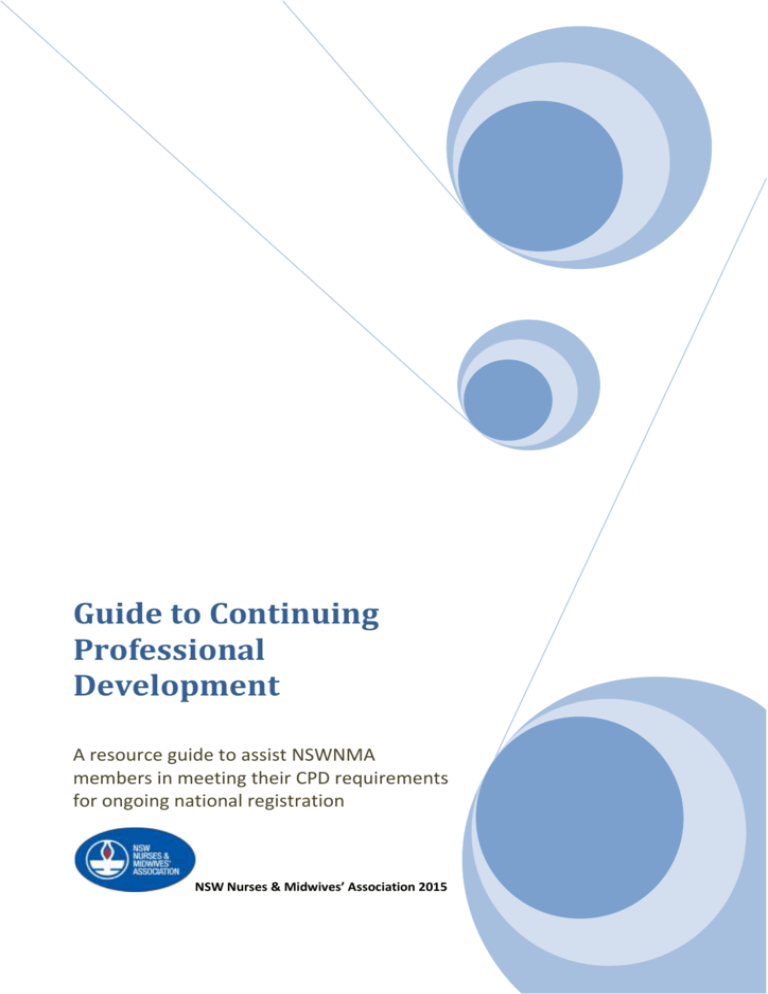
Guide to Continuing Professional Development A resource guide to assist NSWNMA members in meeting their CPD requirements for ongoing national registration NSW Nurses & Midwives’ Association 2015 Continuing Professional Development - 2015 Page 2 Continuing Professional Development - 2015 Foreword Under the National Registration and Accreditation Scheme, all nurses and midwives must meet the Nursing and Midwifery Board of Australia’s continuing professional development (CPD) requirements in order to maintain their registration. (Full details can be found at: http://www.nursingmidwiferyboard.gov.au/Registration-Standards.aspx) This means that all practising nurses and midwives must complete 20 hours of CPD per year that is relevant to their context of practice. The Nursing and Midwifery Board of Australia (NMBA) requires practising nurses and midwives to: identify their learning needs based on an evaluation of their practice against recognised professional standards develop a brief learning plan based on the needs identified participate in CPD activities which meet these learning needs reflect on the value of these activities to their practice. Nurses and midwives need to keep evidence of their CPD for a minimum of three years but do not need to submit this evidence each time they renew their registration. Instead, they make an annual statement declaring that they have met the NMBA’s CPD requirements. Nurses and midwives will only be required to submit CPD evidence if they are randomly selected for audit by the NMBA. Prior to the commencement of national registration in July 2010, nurses and midwives in NSW were not required to keep evidence of completion of CPD activities in order to maintain their registration. This new requirement may therefore seem daunting for some nurses and midwives. However, the process of participating in continuing professional development is not new for nurses and midwives; nurses and midwives have always analysed and learned from their experiences to relate their practice to theory and provide knowledge-based care. What is new for many nurses and midwives is the requirement to formalise this process and keep written documentation that demonstrates completion of appropriate CPD. The NMBA’s registration standard for CPD now requires nurses and midwives to take a structured approach to their participation in CPD and to assess their practice against the national competency standards or other accepted professional standards then identify priority areas of learning for improvement of their own practice. This resource provides an outline of the new requirements and how to meet them and includes template tools for nurses and midwives to use in planning and documenting their CPD. Page 3 Continuing Professional Development - 2015 Page 4 Continuing Professional Development - 2015 Therefore, as registered health practitioners, nurses and midwives have a professional obligation to maintain their competence and to aim for continuous improvement in the standard of service they provide. What is Continuing Professional Development? Continuing Professional Development (CPD) is the purposeful maintenance and improvement of a professional’s knowledge and skills to remain competent in their chosen profession for the benefit of themselves, their patients or clients and the wider profession. CPD is recognised as a commitment to being professional, keeping up to date and continuously seeking to improve. Accordingly, nurses and midwives must complete CPD activities to meet the Nursing and Midwifery Board of Australia’s (NMBA’s) mandatory requirements for ongoing registration. (Full details can be accessed from the NMBA’s website: http://www.nursingmidwiferyboard.gov.au/Registration -Standards.aspx) CPD is intended to encourage the development of professionals so that they reflect on their practice and its quality, are able to adopt and assess new approaches to their practice and develop better ways of working as a result. Why didn’t the NSW Nurses and Midwives Board require nurses and midwives to complete CPD prior to July 2010? CPD acknowledges varying learning styles among professionals and includes a wide range of formal and informal learning activities. The key principles behind CPD are that it: Unlike many other countries and some states and territories of Australia, nurses in New South Wales were not required to provide evidence of completion of CPD activities for renewal of registration prior to 1 July 2010. Instead, the Nurses and Midwives Board of NSW established the ANMC’s Code of Professional Conduct as setting out guidelines that should be observed by nurses in their professional practice. The Code requires all nurses to maintain competence for current practice, including participation in ongoing professional development. Is self-directed Is based on learning needs identified by the individual Builds on an individual’s existing knowledge and experience Links an individual’s learning to their practice Includes an evaluation of the individual’s development. The national registration scheme has now determined that requiring the completion of CPD for ongoing registration provides a more effective way of ensuring that all nurses and midwives maintain their competence for current practice. Why is CPD necessary? CPD is a critical mechanism in ensuring that all members of the nursing and midwifery professions are able to deliver high quality nursing and midwifery care and services and keep pace with health care developments that affect their practice. Who is required to complete CPD? The knowledge needed to function effectively as a professional nurse or midwife continues to expand and change while consumer demand and expectations continue to increase. Page 5 The NMBA requires all practising registered and enrolled nurses, registered nurses endorsed as nurse practitioners, midwives and midwives endorsed as eligible midwives and midwife practitioners to complete CPD. ‘Practising’ includes all clinical and non-clinical roles related to the delivery of nursing and Continuing Professional Development - 2015 midwifery services. ‘Non-clinical’ encompasses roles such as management, education, research, policy development, regulatory and industrial. ongoing registration; only hours may be counted. Students or nurses or midwives who have nonpractising registration are not required to complete CPD. Nurses and midwives may participate in formal CPD programs run by nursing or midwifery organisations but will need to calculate the number of hours the program represents for them to be recognised as CPD by the NMBA. What must nurses and midwives do to meet the NMBA’s annual CPD requirements? What activities can be included in CPD? There are no compulsory or prescribed activities for nursing and midwifery CPD. There are also no particular restrictions on the types or number of activities that may be included as nursing or midwifery CPD. The NMBA requires all practising registered and enrolled nurses and midwives to complete at least 20 hours of CPD per year. The CPD hours must be relevant to the individual nurse’s or midwife’s context of practice. The NMBA expects only that the CPD is relevant to the nurse’s or midwife’s context of practice and that the activities undertaken meet the individual learning needs of the nurse or midwife. If an individual is both a registered nurse and a midwife they must complete 20 hours of nursing CPD and 20 hours of midwifery CPD, unless the CPD activities are relevant to both professions, when they may be counted as evidence for both nursing and midwifery. Possible CPD activities may include, but are not limited to: Registered nurses who hold endorsements under the National Law must complete at least a further 10 hours per year in CPD related to their endorsement. Midwives endorsed as ‘eligible midwives’ under the National Law must complete a further 20 hours of CPD for their endorsement. What is an hour of CPD? One hour of CPD equals one hour of active learning. It is the nurse’s or midwife’s responsibility to calculate how many hours of active learning have taken place. Are CPD points required by the NMBA? No. CPD points are offered by several professional organisations and employers for their own professional development or continuing education programs. However, the use of CPD ‘points’ is not relevant to the NMBA’s requirements for CPD, i.e. the requirements for Page 6 Reflecting on feedback, keeping a practice journal Acting as a preceptor/mentor/tutor Participating on accreditation, audit or quality improvement committees Undertaking supervised practice for skills development Participating in clinical audits, critical incident monitoring, case reviews and clinical meetings Participating in a professional reading and discussion group Developing skills in IT, numeracy, communications, improving own performance, problem solving and working with others Writing or reviewing educational materials, journal articles, books Active membership of professional groups and committees Reading professional journals or books Continuing Professional Development - 2015 Must nurses and midwives provide evidence of CPD to the NMBA every time they renew their registration? Writing for publication Developing policy, protocols or guidelines Working with a mentor to improve practice Presenting at or attending workplace education, in-service sessions or skills workshops Undertaking undergraduate or postgraduate studies which are of relevance to the context of practice Presenting at or attending conferences, lectures, seminars or professional meetings Conducting or contributing to research Undertaking relevant online or distance education Mandatory in-service education that is directly related to an individual’s context of practice. No. Nurses and midwives will only be required to make an annual statement when they renew their registration which includes a declaration that they have met the NMBA’s requirements for CPD. The NMBA will audit a small percentage of randomly selected nurses and midwives each year. If a nurse or midwife is selected for audit, they will then be required to provide evidence of their CPD to the NMBA. All registrants will be allowed a minimum of at least 12 months in the national scheme before being selected for audit. Is there a prescribed way to record CPD evidence? No. Nurses and midwives must keep written documentation of their CPD that demonstrates completion of a minimum of 20 hours of CPD per year but there is no set format prescribed by the NMBA for demonstration of CPD evidence by nurses and midwives. Can mandatory in-service education be included in CPD? Yes, if it is directly relevant to a nurse’s or midwife’s context of practice and contributes to development of their practice, mandatory inservice education can be included in CPD. Nurses and midwives may develop their own formats for documentation of their CPD evidence or may use formats or templates that have been developed by education providers, employers or professional associations. Does CPD need to be provided by an accredited organisation? No. CPD activities may be undertaken in a range of ways including: self-directed, workplace based or through seminars, conferences or formal programs offered by professional organisations and education providers. The important point is that the activities are relevant to the individual nurse’s or midwife’s context of practice and are able to meet their learning needs. Some education providers, employers or professional associations advocate the use of ‘professional portfolios’. This is a sensible approach for nurses and midwives to organise the information which supports their professional practice, including evidence of CPD. Nurses and midwives may choose to keep a professional portfolio but this is not a requirement of the NMBA for CPD evidence. Page 7 Continuing Professional Development - 2015 What must nurses and midwives include in the documentation of their CPD evidence? The NMBA expects nurses and midwives to demonstrate that they have taken a planned approach to completion of their CPD for the year. How long should nurses and midwives keep evidence of their CPD? The NMBA currently recommends that nurses and midwives should keep their CPD evidence for a minimum of three years. This requires nurses and midwives to: reflect on the value of these activities to their practice. This means that nurses and midwives need to keep evidence that explains why they chose the particular CPD activity and how it met their learning needs; how it was relevant to their context of practice; what they learnt from the activities and how it contributed to their practice. Documentation of CPD evidence must include dates of the CPD activities, a brief description of the outcomes of the activities, and the number of hours spent in each activity. All evidence should be verified. identify their learning needs based on an evaluation of their practice against recognised professional standards develop a brief learning plan based on the needs identified participate in CPD activities which meet these learning needs However, this period may be extended to 5 years following finalisation and release of the NMBA’s audit policy. Page 8 Continuing Professional Development - 2015 CPD – where to start? The NMBA’s requirements for CPD mean that nurses and midwives must take a structured approach to their participation in CPD and assess their practice against the national competency standards or other accepted professional standards then identify priority areas of learning for improvement of their own practice. This requires the following steps: Reflect and assess practice Reflect on the contribution of CPD to your practice Identify learning needs Develop learning plan Participate in CPD activities The rest of this resource provides template tools and key tips for you to complete these steps. Page 9 Continuing Professional Development - 2015 Reflecting on practice Name Practice Year Role and position Reflective practice notes provide a format for you to record your reflections on your practice and identify strengths or areas that you assess as needing development in your practice. Description of situation (Date? What happened?) Analysis of situation (What went well? What was difficult? What could you do differently?) Identification of area of practice to be developed (Did your practice meet professional standards? What area do you need to work on in your practice?) Page 10 Continuing Professional Development - 2015 Notes __________________________________________________________________________________________ __________________________________________________________________________________________ __________________________________________________________________________________________ __________________________________________________________________________________________ __________________________________________________________________________________________ __________________________________________________________________________________________ __________________________________________________________________________________________ __________________________________________________________________________________________ __________________________________________________________________________________________ __________________________________________________________________________________________ __________________________________________________________________________________________ __________________________________________________________________________________________ __________________________________________________________________________________________ __________________________________________________________________________________________ __________________________________________________________________________________________ __________________________________________________________________________________________ __________________________________________________________________________________________ __________________________________________________________________________________________ __________________________________________________________________________________________ __________________________________________________________________________________________ __________________________________________________________________________________________ ____________________________________________________ ____________________________________________________ ____________________________________________________ ____________________________________________________ ____________________________________________________ ____________________________________________________ ____________________________________________________ ____________________________________________________ ____________________________________________________ ____________________________________________________ ______________ Page 11 Key Tips for assessing practice • Analyse your reflections against professional and/or competency standards. • Is there a particular aspect that you want to work on? • Determine the most important area(s) to focus on for the upcoming practice year. Continuing Professional Development - 2015 Learning Plan Name Practice Year Role and position The learning plan is a personal guide for your CPD activities. The learning plan provides a structured way for you to develop learning objectives based on the learning needs you identified following assessment of your practice and to identify and complete learning activities to address the needs you identified. Competency standard Learning objective (i.e. what do you want to learn?) Why is this learning objective important to your context of practice? Learning (CPD) activities Hours How did the CPD activity you completed contribute to your practice? Page 12 Dates Completed Continuing Professional Development - 2015 Notes __________________________________________________________________________________________ __________________________________________________________________________________________ __________________________________________________________________________________________ __________________________________________________________________________________________ __________________________________________________________________________________________ __________________________________________________________________________________________ __________________________________________________________________________________________ __________________________________________________________________________________________ __________________________________________________________________________________________ __________________________________________________________________________________________ __________________________________________________________________________________________ __________________________________________________________________________________________ __________________________________________________________________________________________ __________________________________________________________________________________________ __________________________________________________________________________________________ ______________________________________ ______________________________________ ______________________________________ ______________________________________ Key Tips for creating a learning plan • ______________________________________ ______________________________________ ______________________________________ ______________________________________ ______________________________________ ______________________________________ ______________________________________ ______________________________________ ______________________________________ ______________________________________ ______________________________________ ______________________________________ ______________________________________ • Following your reflection and assessment create a learning plan that focuses on the priority area you identified. Develop realistic learning objectives by asking: o What knowledge/skill do you want to gain? o How will you acquire this knowledge/skill? o What performance do you expect to demonstrate as a result of this new learning? o When will this learning be accomplished? o How does this relate to your role and practice? Page 13 Continuing Professional Development - 2015 Recording other learning Name Practice Year Role and position Other learning activities During the practice year you may participate in learning activities that were not included in your learning plan, e.g. an in-service at your facility or a new education session through your professional association. This table allows you to record these activities as they occur. Date Activity Competency/ professional standard (if related) Page 14 Impact on practice Continuing Professional Development - 2015 Notes __________________________________________________________________________________________ __________________________________________________________________________________________ __________________________________________________________________________________________ __________________________________________________________________________________________ __________________________________________________________________________________________ __________________________________________________________________________________________ __________________________________________________________________________________________ __________________________________________________________________________________________ __________________________________________________________________________________________ __________________________________________________________________________________________ __________________________________________________________________________________________ __________________________________________________________________________________________ __________________________________________________________________________________________ __________________________________________________________________________________________ ____________________________________ ____________________________________ ____________________________________ ____________________________________ ____________________________________ Key Tips for implementing your learning plan and tracking other learning • ____________________________________ ____________________________________ • ____________________________________ ____________________________________ ____________________________________ ____________________________________ ____________________________________ ____________________________________ ____________________________________ ____________________________________ ____________________________________ ____________________________________ • As you complete each planned learning activity, document its completion on your Learning Plan You may identify additional learning activities that assist you in meeting your learning objectives, record them as well. To start assessment for the next practice year, reflect on the benefit of the learning you completed by asking: o Did the learning activities help you meet your learning objectives? o Was/were the learning objective(s) you set realistic and achievable? o Did you encounter any resistance or challenges associated with completing your learning activities? ____________________________________ Page 15 Continuing Professional Development - 2015 CPD Summary Name Practice Year Role and position The CPD summary provides a template for you to keep an ongoing log of the CPD activities and number of hours that you have completed so you can check your progress for the practice year. Key Dates Activity Hours completed Page 16 Impact on practice Continuing Professional Development - 2015 Notes __________________________________________________________________________________________ __________________________________________________________________________________________ __________________________________________________________________________________________ __________________________________________________________________________________________ __________________________________________________________________________________________ __________________________________________________________________________________________ __________________________________________________________________________________________ __________________________________________________________________________________________ __________________________________________________________________________________________ __________________________________________________________________________________________ __________________________________________________________________________________________ __________________________________________________________________________________________ __________________________________________________________________________________________ __________________________________________________________________________________________ __________________________________________________________________________________________ __________________________________________________________________________________________ ________________________________________ ________________________________________ ________________________________________ ________________________________________ ________________________________________ Key Tips for documenting your CPD evidence • ________________________________________ ________________________________________ ________________________________________ ________________________________________ • ________________________________________ ________________________________________ ________________________________________ ________________________________________ ________________________________________ ________________________________________ ________________________________________ Page 17 Documentation of your CPD evidence provides an official record that demonstrates the assessment, planning, implementation and evaluation you have undertaken. Documentation of your CPD evidence should adhere to the following principles: o Factual accuracy o Accountability o Timeliness o Confidentiality for interactions with clients and/or other health professionals NSW Nurses and Midwives’ Association 2015 Page 18
